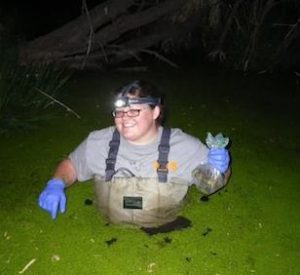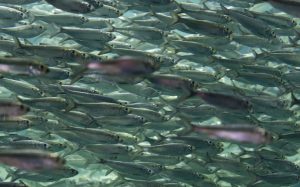How do Dam Decisions get Made?
Sarah Vogel investigates the human dimensions of dam relicensing
Master’s student Sarah Vogel graduated from Tennessee Technological University with dual degrees in Environmental Biology and Wildlife and Fishery Sciences, which gave her some of the skills needed for her work on the Mitchell Center’s Future of Dams (FoD) project.

But it was her two years working in retail following college that prepared her best for her FoD role investigating the dam relicensing process as it relates to Federal Energy Regulatory Commission (FERC)-regulated hydropower dams in Maine.
“More than anything, my background in retail will be helpful because this project is focused on human dimensions,” asserts Vogel. “It will involve my talking to and interviewing federal and state agency stakeholders, as well as various tribal entities.” She adds, “It may sound cliché, but retail experience really did allow me to learn how to talk to people.”
Vogel and other researchers will be striving to understand stakeholder actions and identify potential knowledge gaps in the process that can be used to inform dam decision making.
Fittingly, for the project, Vogel’s co-advisors represent both the natural science and human dimension side of policy decision making. “It’s really interesting seeing how their different perspectives shape the work we’re doing,” says Vogel.
Vogel has been focusing her initial efforts into a targeted content analysis of the FERC eLibary, a repository of all documents relating to US energy projects. She’s been looking back through decades of information to gauge how decision making has changed over time and examining factors that influence decision making about fish passage specifically.
Vogel will present a talk on her work titled “Fish Passage at Hydropower Dams on the Penobscot and Kennebec Rivers: A Content Analysis of the FERC eLibrary Database” at the 2018 Sustainability and Water Conference on Thursday, March 29 at the Augusta Civic Center as part of the “Rivers and Their Fish” concurrent session.
Vogel and her colleagues are using content analyses of FERC documents to provide insights into the factors affecting decision making regarding fish passage and how those decisions play out between agencies/entities.
“We want to determine what state and federal agencies and tribal entities are interested in with respect to the relicensing process—what’s important to them, what tools are at their disposal, and what gaps in their knowledge there might be that they’d like to see filled,” Vogel says.
The future of dams
Hydropower is a major source of renewable energy in New England. More than 50 hydropower dams in the region are scheduled for relicensing in the next decade, requiring communities to make critical decisions about the future of this infrastructure. Iconic mill dams are also an integral part of New England’s industrial history and continue to provide some recreational, water supply, and aesthetic benefits for many communities.
Despite these positive aspects, dams can have adverse effects on ecosystems and economies. They can block economically and ecologically important fish migrations, and some old, obsolete dams pose safety and liability risks as aging infrastructure could fail and flood surrounding areas. Concerns about trade-offs among hydropower, fish passage, safety issues, water supply, and other issues complicate decisions to remove, relicense, or retrofit existing dams.
With so many competing interests over the presence and function of dams, decisions about their future must be made thoughtfully, integrating environmental, social, and economic tradeoffs.
Vogel notes that the FoD project involves an eclectic mix of researchers that are using a wide range of methods to examine dams and decision making.
“I feel very fortunate to be working with this great group of people from diverse backgrounds. The Mitchell Center is a fantastic space for spanning disciplines…” —Sarah Vogel
“We all have these different project pieces, hydrologic modeling and nutrient cycling, for example. My project is directed towards fish passage decision making between agencies and tribal entities—towards the people actually making decisions in these processes,” Vogel says.
She adds, “I feel very fortunate to be working with this great group of people from diverse backgrounds. The Mitchell Center is a fantastic space for spanning disciplines” in order to work on problems to which there are no easy comprehensive policy or social solutions.
As part of the overall process, the team is developing different strategies to recommend to people so they can make more informed decisions.
“For my portion of the project, one aspect I’m interested in is looking at the decision making in an historical context. I’ll be asking specific questions about decisions and how/why they were made for certain projects,” Vogel says.
“What has happened before, what could change, what is an example of a dam with great fish passage and why did that come about when it didn’t at another location? We really want to identify the factors that lead to informed decision making.”
Beginning in the spring 2018 semester, Vogel will conduct interviews with federal and state agency representatives as well as members from various tribal entities, all of which will further develop ideas and investigate patterns found from the eLibrary content analysis of a massive 33,488 individual documents.
The agencies/entities Vogel will conduct interviews with include National Oceanic and Atmospheric Administration (NOAA) Fisheries, US Fish and Wildlife Service, Maine Department of Marine Resources, Maine Department of Inland Fisheries and Wildlife, Maine Department of Environmental Protection, and the Penobscot Indian Nation.
In the fall 2017 semester, Vogel started classes in human dimensions of wildlife management and courses covering various interpretive analytical traditions in the social sciences. She notes that both courses “have been really eye-opening” and have expanded her ability to view and analyze complex, multidimensional sustainability problems like dam decision making and, specifically, fish passage as part of that.
“To tackle these big problems, you need multiple perspectives,” Vogel says. “And in this specific case, it’s not just about how many fish got through the fish ladder, it’s about why people made the decisions they made and how they can possibly influence outcomes in the future. So, it’s as much about people as it is about fish.”
—David Sims
